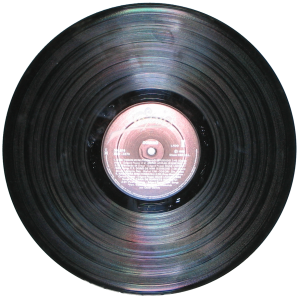Good morning, Whitewater.
Thursday in Whitewater will be cloudy with a high of seventy-eight. Sunrise is 5:15 and sunset 8:36, for 15h 20m 15s of daytime. The moon is a waxing crescent with 3.9% of its visible disk illuminated.
CBS Laboratories head research scientist Peter Goldmark led Columbia’s team to develop a phonograph record that would hold at least 20 minutes per side.[7] The team included Howard H. Scott, who died September 22, 2012, at the age of 93.[8]
Research began in 1941, was suspended during World War II, and then resumed in 1945.[9] Columbia Records unveiled the LP at a press conference in the Waldorf Astoria on June 18, 1948, in two formats: 10 inches (25 centimetres) in diameter, matching that of 78 rpm singles, and 12 inches (30 centimetres) in diameter.[10] The initial release of 132 were: 85 twelve-inch classical LP’s, 26 ten-inch classics, 18 ten-inch popular numbers and 4 ten-inch juvenile records. According to the 1949 Columbia catalog, issued for August 1948, the first twelve-inch LP was ML 4001 Nathan Milstein performing the Mendelssohn violin concerto. Three ten-inch series were released: ‘popular’, starting with CL 6001, a Frank Sinatra album, and ‘classical’, numbering from Beethoven’s 8th symphony ML 2001, and ‘juvenile’, commencing with JL 8001 (nursery songs). Also released at this time were a pair of 2-LP sets, La Bohème, SL-1 and Hansel & Gretel, SL-2.[11]
….When the LP was introduced in 1948, the 78 was the conventional format for phonograph records. By 1952, 78s still accounted for slightly more than half of the units sold in the United States, and just under half of the dollar sales. The 45, oriented toward the single song, accounted for just over 30% of unit sales and just over 25% of dollar sales. The LP represented not quite 17% of unit sales and just over 26% of dollar sales.[12]
Ten years after their introduction, the share of unit sales for LPs in the US was almost 25%, and of dollar sales 58%. Most of the remainder was taken up by the 45; 78s accounted for only 2% of unit sales and 1% of dollar sales.[6] For this reason, major labels in the United States ceased manufacturing of 78s for popular and classical releases in 1956 with the minor labels following suit, with the final US-made 78 being produced in 1959.
Canada and the UK continued production into 1960 and India, the Philippines and South Africa continued to produce 78s up until 1965, with the last holdout, Argentina continuing the practice until 1970.
The LP’s popularity ushered in the Album Era of English-language popular music beginning in the 1960s as performers took advantage of the longer playing time to create coherent themes or concept albums. Although the popularity of LPs fell in the late 1970s with the advent of firstcassettes and later compact discs, the album survived as a popular format well into the 2000s.
Vinyl LP records have enjoyed an increased resurgence amongst a younger generation in the early 2010s.[13] Vinyl sales in the UK reached 2.8 million in 2012.[14]
Here’s Puzzablity‘s game for Thursday:
|
This Week’s Game — June 15-19
|
|||||
|
Make Room for Dad
|
|||||
|
We’re mixing it up with pop this Father’s Day. For each day this week, we started with a word or phrase, added the three letters in DAD, and rearranged all the letters to get a new phrase. Both pieces are described in each day’s clue, with the shorter one first.
|
|||||
|
Example:
|
|||||
|
Overweight; heroically turned the tide from bad to good
|
|||||
|
Answer:
|
|||||
|
Heavyset; saved the day
|
|||||
|
What to Submit:
|
|||||
|
Submit both pieces, with the shorter one first (as “Heavyset; saved the day” in the example), for your answer.
|
|||||
|
Thursday, June 18
|
|||||
|

